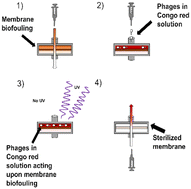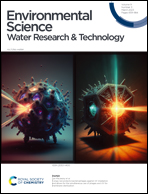Congo red protects bacteriophages against UV irradiation and allows for the simultaneous use of phages and UV for membrane sterilization†
Abstract
The membrane bioreactor market has been expected to grow by 4.9 billion USD within five years – from 2021 to 2026. Biofouling caused by the deposition of microorganisms and their extracellular substances decreases the operational flux of the membrane bioreactor, increasing the energy consumption costs of bioreactor maintenance. Standard protocols are costly and time-consuming, and generate harmful waste. Here, a method for the simultaneous utilization of UV light and bacteriophages for efficient sterilization of bacteria-contaminated membranes is demonstrated. Congo red, a commonly used dye, provides selective protection of phages, but not bacteria, against UV radiation. This allows for overcoming the significant drawback of such protocols – the phage inactivation by UV. The simultaneous utilization of phages, UV, and Congo red resulted in the complete removal of bacteria from membranes (>4 log) within just 30 minutes. This is also the first attempt to describe the UV-protective property mechanism of dyes.

- This article is part of the themed collection: Recent Open Access Articles


 Please wait while we load your content...
Please wait while we load your content...